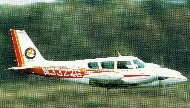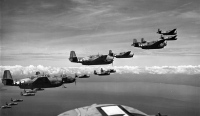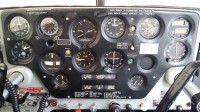I routinely start up on the right tank and keep it there until time for run up. I then switch to the left tank for run up and keep it there for takeoff.
But what about the tip tanks? Is there a way to prove fuel system integrity with the fuel pressure? This is in regards to a carburetor engine, 250. If a tip tank line was blocked or what have you, wouldn't it take several seconds or perhaps minutes for this to be a problem?
Fuel pressure / test
6 posts
• Page 1 of 1
Re: Fuel pressure / test
Tip tanks are hard to check on the ground because it will take awhile to show that you have a problem. In the twin, I switch to the tips first in cruise, so I know then if I have a problem and can go back to the mains.
Kristin
-

Kristin Winter - ICS member

- Posts: 1299
- Joined: Tue Aug 09, 2005 5:21 pm
- Location: Northern California
Re: Fuel pressure / test
I recently read the POH section for the tip tanks on my Twin - don't know if it is different for the singles. The pre-flight draining can help but there is not guarantee.
Pat
Patricia Jayne (Pat) Keefer ICS 08899
PA-39 #10 Texas
Patricia Jayne (Pat) Keefer ICS 08899
PA-39 #10 Texas
-

N3322G - ICS member

- Posts: 1911
- Joined: Thu May 08, 2008 1:58 pm
- Location: Fort Worth, Texas area
Re: Fuel pressure / test
Hi William,
I second what Kristin has to say. I fly a 1959 250 with the tip tanks. If you're planning a flight with fuel in the tips, after you reach cruise altitude, use the tips first. If you have a problem, you'll have lots of altitude underneath you to get back on the main tank with plenty of fuel in it (them). Then you'll have plenty of time to figure out what you want to do about it. Whenever I switch tanks, I am very alert for signs of trouble for several minutes after the switch. Once I've reached the 4 to 5 minute mark after the switch with no sign of trouble, my confidence in the selected tank is very good! Prior to that time frame, I'm on "high alert."
My personal technique is to not take off until the engine has been running on my selected main tank, including the run-up, for at least 5 minutes, preferably a little more. If you switch tanks on your way to the runway or at the run up area, I wouldn't take off for at least 5 minutes. I figure if I take off with plenty of fuel in my selected main tank, the other three tanks I'm willing to confirm there integrity at altitude knowing I always have plenty of time left in my first selected main tank if I run into problems with any of the other three tanks.
Hope this helps!
Ed
I second what Kristin has to say. I fly a 1959 250 with the tip tanks. If you're planning a flight with fuel in the tips, after you reach cruise altitude, use the tips first. If you have a problem, you'll have lots of altitude underneath you to get back on the main tank with plenty of fuel in it (them). Then you'll have plenty of time to figure out what you want to do about it. Whenever I switch tanks, I am very alert for signs of trouble for several minutes after the switch. Once I've reached the 4 to 5 minute mark after the switch with no sign of trouble, my confidence in the selected tank is very good! Prior to that time frame, I'm on "high alert."
My personal technique is to not take off until the engine has been running on my selected main tank, including the run-up, for at least 5 minutes, preferably a little more. If you switch tanks on your way to the runway or at the run up area, I wouldn't take off for at least 5 minutes. I figure if I take off with plenty of fuel in my selected main tank, the other three tanks I'm willing to confirm there integrity at altitude knowing I always have plenty of time left in my first selected main tank if I run into problems with any of the other three tanks.
Hope this helps!
Ed
- Ed Asmus
- Posts: 72
- Joined: Wed Sep 11, 2013 5:02 am
Re: Fuel pressure / test
Hi William,
I concur with Ed that it isn't a great idea to take off shortly after switching tanks. You could have just enough fuel in the lines to get yourself into a bad situation.
PatD
I concur with Ed that it isn't a great idea to take off shortly after switching tanks. You could have just enough fuel in the lines to get yourself into a bad situation.
PatD
-

Pat Donovan - ICS Treasurer

- Posts: 93
- Joined: Sun Jul 11, 2004 3:32 pm
- Location: Troy, MO
Re: Fuel pressure / test
That makes a great deal of sense!
-

William Hughes - Posts: 97
- Joined: Mon Apr 21, 2014 9:23 pm
- Location: Saskatoon, SK
6 posts
• Page 1 of 1
Return to Maintenance - Powerplant
Who is online
Users browsing this forum: No registered users and 3 guests
